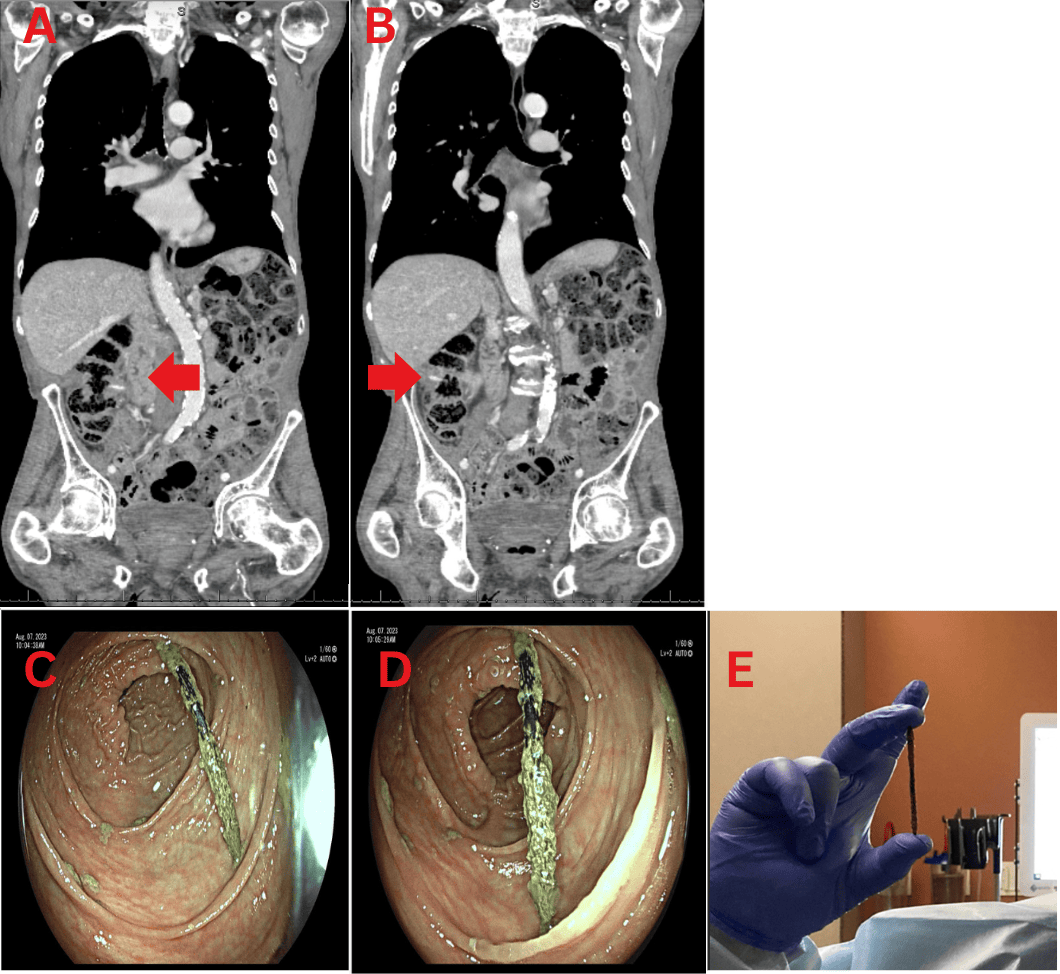Monday Poster Session
Category: General Endoscopy
P3043 - Silent Ingestion, Safe Removal: A Successful Endoscopic Removal of a 10cm Wooden Toothpick in the Colon
Monday, October 27, 2025
10:30 AM - 4:00 PM PDT
Location: Exhibit Hall
.jpeg.jpg)
KiBeom Kwon, MD (he/him/his)
Virginia Mason Franciscan Health
Seattle, WA
Presenting Author(s)
KiBeom Kwon, MD1, Nazar Hafiz, MD2
1Virginia Mason Franciscan Health, Seattle, WA; 2Washington State University Elson S. Floyd School of Medicine, Richland, WA
Introduction: Foreign body ingestion, though uncommon, can become life-threatening when sharp objects perforate the gastrointestinal tract. Patients typically present with acute abdominal symptoms, peritonitis, or sepsis. We present a rare case of an elderly patient with silent ingestion of a large wooden toothpick, without peritonitis, which was successfully removed via colonoscopy.
Case Description/
Methods: An 83-year-old male with a history of uncontrolled type II diabetes, stage 3 chronic kidney disease, mixed hyperlipidemia, and hypertension presented for routine primary care follow-up. He reported a recent fall and three months of unintentional weight loss, followed by intermittent right lower quadrant abdominal discomfort and increased constipation. He denied hematochezia, hematuria, abdominal pain, or respiratory symptoms. Physical exam was unremarkable. A CT scan of the chest, abdomen, and pelvis was performed to evaluate his weight loss. It revealed a 10 cm linear hyperdense object traversing the ascending colon wall with associated mural wall thickening (Figure 1A and B). There was no evidence of intraperitoneal free air, fluid, or abscess. Colonoscopy revealed a wooden toothpick lying freely in the ascending colon, without surrounding fibrosis or mucosal embedding (Figure 1C and D). The remainder of the examined colon appeared normal. The toothpick was successfully removed using rat-toothed forceps (Figure 1E). The patient recovered well, resumed his normal diet the next day, and was started on daily polyethylene glycol for constipation.
Discussion: While most ingested foreign bodies pass spontaneously through the gastrointestinal tract without complication, sharp and rigid objects such as toothpicks pose a higher risk of mucosal injury, impaction, and perforation. Ingestion is often unintentional and unrecognized, particularly in older adults. This case expands our understanding of the spectrum of foreign body ingestion and the importance of detailed history and imaging review in patients with unusual presentations, such as unexplained weight loss only. It also illustrates that, in selected cases without signs of acute perforation or sepsis, endoscopic retrieval of deeply located foreign bodies in the colon can be safe and effective, especially when clinical and radiographic information excludes complications.

Figure: Figure 1A and B: Coronal images showing the foreign body in the right lower quadrant of the abdomen.
Figure 1C and D: A wooden toothpick in the ascending colon, not embedded in the mucosa.
Figure 1E: Successful removal of a large wooden toothpick, 10 cm long.
Disclosures:
KiBeom Kwon indicated no relevant financial relationships.
Nazar Hafiz indicated no relevant financial relationships.
KiBeom Kwon, MD1, Nazar Hafiz, MD2. P3043 - Silent Ingestion, Safe Removal: A Successful Endoscopic Removal of a 10cm Wooden Toothpick in the Colon, ACG 2025 Annual Scientific Meeting Abstracts. Phoenix, AZ: American College of Gastroenterology.
1Virginia Mason Franciscan Health, Seattle, WA; 2Washington State University Elson S. Floyd School of Medicine, Richland, WA
Introduction: Foreign body ingestion, though uncommon, can become life-threatening when sharp objects perforate the gastrointestinal tract. Patients typically present with acute abdominal symptoms, peritonitis, or sepsis. We present a rare case of an elderly patient with silent ingestion of a large wooden toothpick, without peritonitis, which was successfully removed via colonoscopy.
Case Description/
Methods: An 83-year-old male with a history of uncontrolled type II diabetes, stage 3 chronic kidney disease, mixed hyperlipidemia, and hypertension presented for routine primary care follow-up. He reported a recent fall and three months of unintentional weight loss, followed by intermittent right lower quadrant abdominal discomfort and increased constipation. He denied hematochezia, hematuria, abdominal pain, or respiratory symptoms. Physical exam was unremarkable. A CT scan of the chest, abdomen, and pelvis was performed to evaluate his weight loss. It revealed a 10 cm linear hyperdense object traversing the ascending colon wall with associated mural wall thickening (Figure 1A and B). There was no evidence of intraperitoneal free air, fluid, or abscess. Colonoscopy revealed a wooden toothpick lying freely in the ascending colon, without surrounding fibrosis or mucosal embedding (Figure 1C and D). The remainder of the examined colon appeared normal. The toothpick was successfully removed using rat-toothed forceps (Figure 1E). The patient recovered well, resumed his normal diet the next day, and was started on daily polyethylene glycol for constipation.
Discussion: While most ingested foreign bodies pass spontaneously through the gastrointestinal tract without complication, sharp and rigid objects such as toothpicks pose a higher risk of mucosal injury, impaction, and perforation. Ingestion is often unintentional and unrecognized, particularly in older adults. This case expands our understanding of the spectrum of foreign body ingestion and the importance of detailed history and imaging review in patients with unusual presentations, such as unexplained weight loss only. It also illustrates that, in selected cases without signs of acute perforation or sepsis, endoscopic retrieval of deeply located foreign bodies in the colon can be safe and effective, especially when clinical and radiographic information excludes complications.

Figure: Figure 1A and B: Coronal images showing the foreign body in the right lower quadrant of the abdomen.
Figure 1C and D: A wooden toothpick in the ascending colon, not embedded in the mucosa.
Figure 1E: Successful removal of a large wooden toothpick, 10 cm long.
Disclosures:
KiBeom Kwon indicated no relevant financial relationships.
Nazar Hafiz indicated no relevant financial relationships.
KiBeom Kwon, MD1, Nazar Hafiz, MD2. P3043 - Silent Ingestion, Safe Removal: A Successful Endoscopic Removal of a 10cm Wooden Toothpick in the Colon, ACG 2025 Annual Scientific Meeting Abstracts. Phoenix, AZ: American College of Gastroenterology.
